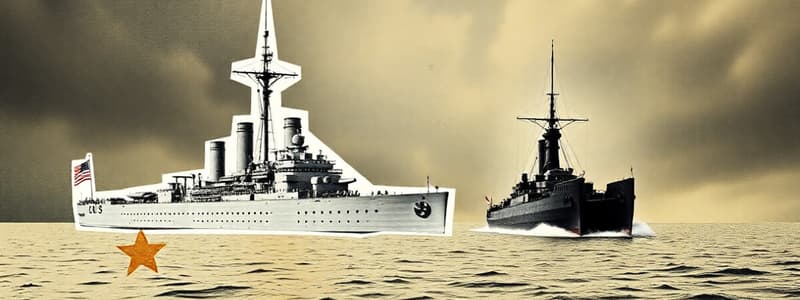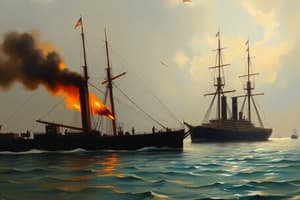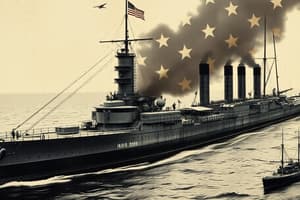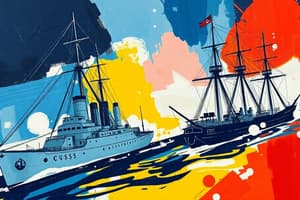Podcast
Questions and Answers
What critical deficiency in the CSS Virginia's design significantly hampered its maneuverability and access to certain waterways?
What critical deficiency in the CSS Virginia's design significantly hampered its maneuverability and access to certain waterways?
Its deep draft of 22 feet.
Explain why Commodore Charles McCauley's efforts to destroy the Gosport Navy Yard were ultimately unsuccessful.
Explain why Commodore Charles McCauley's efforts to destroy the Gosport Navy Yard were ultimately unsuccessful.
The burning was carried out in haste and was insufficient.
What technological limitation prevented the CSS Virginia from effectively engaging the USS Minnesota on the first day of the battle?
What technological limitation prevented the CSS Virginia from effectively engaging the USS Minnesota on the first day of the battle?
Its deep draft.
How did the differing objectives of the USS Monitor and CSS Virginia influence their actions after their engagement?
How did the differing objectives of the USS Monitor and CSS Virginia influence their actions after their engagement?
Discuss the strategic impact of the battle between the Monitor and the Virginia, considering that neither ship was decisively defeated.
Discuss the strategic impact of the battle between the Monitor and the Virginia, considering that neither ship was decisively defeated.
What specific vulnerability of the USS Cumberland made it an easy target for the CSS Virginia?
What specific vulnerability of the USS Cumberland made it an easy target for the CSS Virginia?
Explain how the limited resources of the Confederacy impacted the CSS Virginia's construction.
Explain how the limited resources of the Confederacy impacted the CSS Virginia's construction.
Assess the impact of the CSS Virginia's initial success against the USS Cumberland and USS Congress on the Union's naval strategy.
Assess the impact of the CSS Virginia's initial success against the USS Cumberland and USS Congress on the Union's naval strategy.
What design characteristic of the USS Monitor made it a difficult target for conventional naval artillery?
What design characteristic of the USS Monitor made it a difficult target for conventional naval artillery?
Speculate on why the CSS Virginia was ultimately scuttled by the Confederacy.
Speculate on why the CSS Virginia was ultimately scuttled by the Confederacy.
What specific armament did the USS Monitor possess within its rotating turret, and what made this design innovative for its time?
What specific armament did the USS Monitor possess within its rotating turret, and what made this design innovative for its time?
How did the initial encounter between the CSS Virginia and the USS Congress unfold, and what factors contributed to the Congress's ultimate fate?
How did the initial encounter between the CSS Virginia and the USS Congress unfold, and what factors contributed to the Congress's ultimate fate?
Explain the strategic dilemma faced by the CSS Virginia after its engagement with the USS Monitor, considering its limited maneuverability and the Union's continued blockade.
Explain the strategic dilemma faced by the CSS Virginia after its engagement with the USS Monitor, considering its limited maneuverability and the Union's continued blockade.
In what ways did the battle between the USS Monitor and CSS Virginia mark a significant departure from traditional naval warfare tactics and ship design?
In what ways did the battle between the USS Monitor and CSS Virginia mark a significant departure from traditional naval warfare tactics and ship design?
How did the Confederate's decision to convert the USS Merrimack into the CSS Virginia reflect their strategic objectives and resource constraints?
How did the Confederate's decision to convert the USS Merrimack into the CSS Virginia reflect their strategic objectives and resource constraints?
Critically analyze the decision-making process that led to the Union's construction of the USS Monitor, considering the urgency of the situation and the technological risks involved.
Critically analyze the decision-making process that led to the Union's construction of the USS Monitor, considering the urgency of the situation and the technological risks involved.
Explain the role of CSS Beaufort and CSS Raleigh during the first day of the Battle of Hampton Roads.
Explain the role of CSS Beaufort and CSS Raleigh during the first day of the Battle of Hampton Roads.
How did the performance of the USS Monitor and CSS Virginia in their historic battle influence naval architecture and strategy in the years that followed?
How did the performance of the USS Monitor and CSS Virginia in their historic battle influence naval architecture and strategy in the years that followed?
What tactical advantages did the USS Monitor's rotating turret provide compared to the broadside cannons of traditional warships?
What tactical advantages did the USS Monitor's rotating turret provide compared to the broadside cannons of traditional warships?
What were the material differences between the USS Cumberland and the USS Congress, and how did those differences affect each ship's fate during the battle?
What were the material differences between the USS Cumberland and the USS Congress, and how did those differences affect each ship's fate during the battle?
Flashcards
Gosport Navy Yard
Gosport Navy Yard
Union forces abandoned it, and it was burned to prevent supplies from falling into Confederate hands.
CSS Virginia
CSS Virginia
A casemate ironclad ram, reconstructed from the USS Merrimack by the Confederacy.
Ironclad Board
Ironclad Board
The committee established by the Federals to counter the threat posed by the Confederacy's ironclad ship.
USS Monitor
USS Monitor
Signup and view all the flashcards
CSS Beaufort and CSS Raleigh
CSS Beaufort and CSS Raleigh
Signup and view all the flashcards
USS Cumberland
USS Cumberland
Signup and view all the flashcards
USS Congress
USS Congress
Signup and view all the flashcards
CSS Jamestown & CSS Patrick Henry
CSS Jamestown & CSS Patrick Henry
Signup and view all the flashcards
USS Minnesota
USS Minnesota
Signup and view all the flashcards
Sewell's Point
Sewell's Point
Signup and view all the flashcards
Inconclusive
Inconclusive
Signup and view all the flashcards
Study Notes
- At the start of the war, Union forces abandoned the Gosport Navy Yard and Commodore Charles McCauley ordered it burnt to prevent supplies from falling into Confederate hands.
- The burning of the yard was rushed and incomplete.
- The USS Merrimack was at the yard for repairs, and was burned and scuttled during the evacuation.
- Confederates salvaged the Merrimack's hull and transformed it into the CSS Virginia, a casemate ironclad ram, over nine months.
- Iron plating protected everything above the waterline, but its weight resulted in a deep draft of 22 feet.
- Limited Confederate iron supply and production capacity slowed down the construction.
- The Union responded to the threat of the CSS Virginia by establishing the Ironclad Board, leading to the rushed construction of the USS Monitor.
- The USS Monitor featured a very low freeboard, with just 18 inches between the waterline and the deck.
- The Monitor's primary armament consisted of two 11-inch Dahlgren smoothbore cannons housed within a rotating turret.
- The USS Monitor launched on January 30, 1862, from the New York Navy Yard.
First Day of Battle
- On March 8, 1862, the CSS Virginia, accompanied by the CSS Beaufort and CSS Raleigh, sailed to Hampton Roads to break the Union blockade.
- CSS Virginia rammed and sank the USS Cumberland.
- CSS Virginia and USS Congress exchanged fire until the Congress ran aground and was later burned.
- CSS Jamestown, CSS Patrick Henry, and the CSS Virginia then targeted the grounded USS Minnesota.
- CSS Virginia could not get close enough to engage the Minnesota due to its deep draft.
- The Confederate ships withdrew to Sewell's Point for the night.
Second Day of Battle
- On the morning of March 9, 1862, the CSS Virginia returned to attack the Minnesota.
- The USS Monitor appeared and engaged, causing the CSS Jamestown and CSS Patrick Henry to retreat.
- CSS Virginia and USS Monitor exchanged fire for four hours, damaging each other but neither inflicting a fatal blow.
- The USS Monitor remained to protect the Minnesota until tugs freed it later that night.
- The CSS Virginia returned to the yard for repairs and never reappeared for battle.
- The CSS Virginia was eventually abandoned because of its deep draft preventing it from ascending the James River, and it was eventually scuttled.
Studying That Suits You
Use AI to generate personalized quizzes and flashcards to suit your learning preferences.




